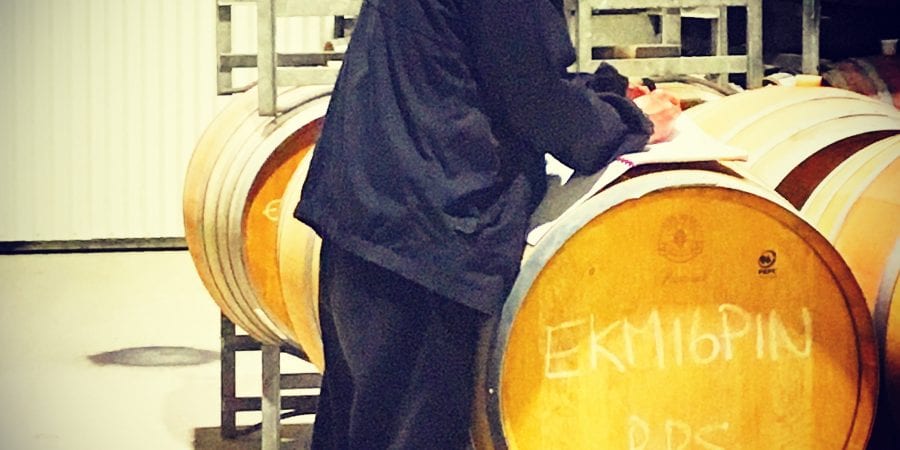This week, in the second part of my wine jargon series I take a look at some of those technical winemaking terms which may have left you scratching your head in the past!
Here we go…
Barrels
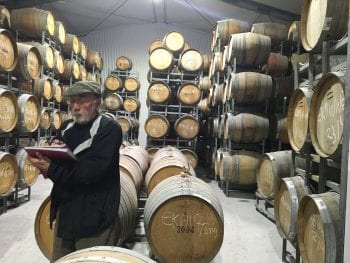 OK, so you probably know what a barrel is. But just in case… it’s any wooden vessel used for fermenting, ageing or transporting wine. Wooden barrels are typically made from French or American oak. Although you can find other types of oak barrels, including Hungarian oak (which, if he can get his hands on it, Rob loves using for our Chardonnay and Fumé Blanc).
OK, so you probably know what a barrel is. But just in case… it’s any wooden vessel used for fermenting, ageing or transporting wine. Wooden barrels are typically made from French or American oak. Although you can find other types of oak barrels, including Hungarian oak (which, if he can get his hands on it, Rob loves using for our Chardonnay and Fumé Blanc).
What you may not know though, it that barrels come in lots of different sizes. And each size has a specific name. Here are a couple of the most common ones…
Barrique: The barrique originated in Bordeaux, and it traditionally holds 225 litres. It is the most common type of wine barrel.
Hogshead: A hogshead barrel holds around 300 litres of wine. It’s the one you’ll see doubling as a backyard bar table or cut in half and used as a planter.
Puncheon: Not as common as Barriques and hogsheads, puncheons hold 500 litres of wine.
Barrels come in many other sizes, but they are also used for other purposes other than winemaking – sherry, whiskey, beer and in the past oil, gunpowder and meat (among other things). The three I have mentioned are the most common sizes used in winemaking. Here is an interesting graphic I found though if you’re keen to see all the different sizes.
The biggest one here is the Tun. It holds around 955 litres (or 252 gallons).
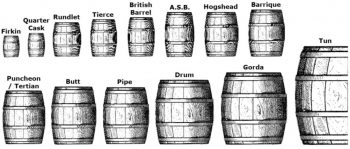
Before I stop going on about barrels, I stumbled across this snippet during my research (thanks to winespectator.com) and had to share…
The world’s largest wine barrel is considered to be the Heidelberg Tun, contained within the cellars of Germany’s Heidelberg Castle. It was built in 1751 from 130 oak trees by Prince Elector Karl Theodor, and it stands 7 meters high, 8 1/2 meters wide, holds 220,000 liters of wine, and has a dance floor built on top of it.
I think we need one for the cellar bar!
Barrel ageing
Actually, before I stop going on about barrels, here are a couple of other terms you might come across…
Rack and return: This term describes the process of pumping wine out of barrels and then returning it once the barrels have been cleaned and any remaining yeast lees (see below for definition) have been removed. This helps to get some air into the wine, keeping it nice and fresh. It also helps to soften the tannins and allows the blending of the different barrels for consistency in the bottle. Rob uses this technique a lot when making his red wines, particularly the Shiraz.
Seasoned barrel: If you hear the term “seasoned” when referring to a barrel, that just means that the barrel has been used before. Usually, a barrel is used two or three times in its life. Over time, it looses its “oakiness”, so a winemaker will either used seasoned barrels for wines not requiring too much “oak” flavour or in conjunction with new barrels.
Winemaking words
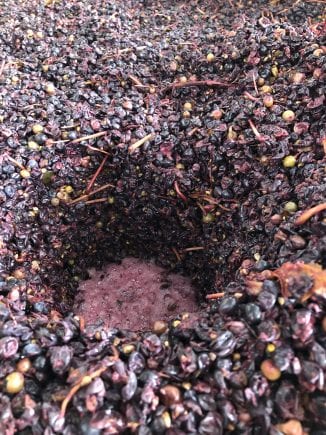 Cap: The ‘“cap” is the layer of grape skins, pips and other solid matter that rises to the surface of the wine during the winemaking process. When making certain styles of red wine, grapes are put through a crusher and then transferred into open fermentation tanks. Once fermentation begins, the grape skins are lifted, raised to the surface by the carbon dioxide gases which are released in the fermentation process. This layer of grape skins and other suspended solids is known as the cap.
Cap: The ‘“cap” is the layer of grape skins, pips and other solid matter that rises to the surface of the wine during the winemaking process. When making certain styles of red wine, grapes are put through a crusher and then transferred into open fermentation tanks. Once fermentation begins, the grape skins are lifted, raised to the surface by the carbon dioxide gases which are released in the fermentation process. This layer of grape skins and other suspended solids is known as the cap.
Marc: This is all the stuff left over from the grapes once the wine is made and has been pressed. It consists of the skins, stalks, and seeds. It’s basically a winery’s waste products.
Lees: Lees are deposits of dead yeast cells or residual yeast and other particles that fall out of the wine to the bottom of the vat after fermentation. You might also hear the term used to describe the ageing process of sparkling wines (in particular). Someone might say the wine has been “on lees” for a certain amount of time. That just means that the wine is left in contact with the lees to develop certain flavours (it’s where the “yeasty” flavours in sparkling come from).
Must: Must is freshly crushed grape juice that contains the skins, seeds, and stems of the fruit. As we already know the solid portion of the must is called the cap and the rest is the grape juice. Making must is the first step in winemaking.
Pressing versus crushing
Pressing, crushing… what’s the difference?
When making white wine, the fruit is usually pressed before primary fermentation. This is a gentle process which minimises the amount of skin contact with the juice. And we know this is super important for a wine like our sparkling.
For (a lot of) red wines though, the grapes are first crushed to maximise the amount of skin contact (where all the colour and flavour are). It is then pressed after fermentation to squeeze out the remainder of the juice and remove the skins and seeds, etc.
There are a couple of good videos in this post from last year that shows some of our Tempranillo grapes getting crushed.
Here is one of them if you don’t have time to click!
While we’re on the topic you should probably be familiar with these terms too…
Freerun: When the maker decides it’s time to press (either before or after fermentation depending on the wine), they firstly separate the liquid portion of the grape juice or wine from the skins, seeds and stalks. There is absolutely no (or very little) pressing involved in this step. The winemaker is relying on gravity and the pressure of the weight of the grapes/cap to gently squeeze the liquid from the solids. That liquid is called the free run.
Time on skins: After primary fermentation is complete, grape skins, seeds and any stems, can be left in contact with the wine for a length of time before pressing. The aim is to increase the extraction of certain compounds from the skins, seeds, and any stems, in order to optimise the colour, flavour and tannin structure of the wine.
Plunging and pumping over
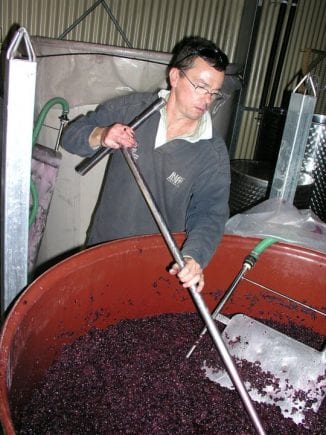 Plunging: As the skins are the source of colour, flavour, aromas and the tannins – the cap needs to be macerated (or mixed in) through the liquid several times each day. This process is called plunging down.
Plunging: As the skins are the source of colour, flavour, aromas and the tannins – the cap needs to be macerated (or mixed in) through the liquid several times each day. This process is called plunging down.
You may also hear it referred to as “pigeage”. That’s just the French term for the traditional plunging of grapes in open-top fermentation tanks.
It is done by hand with a big metal thingymabob. Just like the guy (who may or may not be my husband) in this photo is doing.
Pumping over: This is sort of the same thing as plunging (or at least has the same result) but for wines made on a larger scale. Also known as “remontage” (in French), “pumping over” is the process of pumping red wine up from the bottom of the tank and splashing it over the top of the fermenting must. It encourages greater circulation of the cap throughout the wine.
Vintage vs non-vintage
You’ll often hear these terms in reference to Champagne (and sparkling wine).
The main difference between vintage and non-vintage Champagne, is not that the vintage is old but that it is made from the grapes of only one year’s harvest. On the other hand, non-vintage Champagne is a blend of different years’ harvest.
The Champagne Houses and growers provide a continuous house style through the blending of various vintages, to create the yearly non-vintage Champagne.
Whereas a good quality year, will produce a typically fuller, deeper Champagne, making it a vintage year.
Again, I think I’ve covered enough for one week. I do have some more up my sleeve, but I’ll hang onto them for Part 3 (and maybe more??!)! As always, if you have any questions or wine terms you’d like explained, feel free to send them in.
Tune in next week – we have something big to celebrate!
